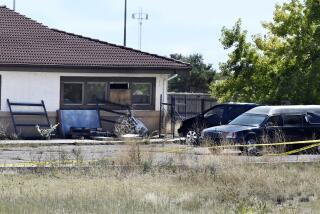Wife, Marines Clash Over Whose Bones Are in Coffin : Vietnam: Woman accidentally discovered husband was reportedly seen alive. His parents think he’s dead.
- Share via
Today at Arlington National Cemetery, the Marines are planning to bury Maj. Hugh Michael Fanning for the second time. At least, that’s whose body the military says is in the coffin.
Fanning’s father and mother will be there. His wife, Kathryn, will not.
In an event that epitomizes one of the agonizing questions of the post-Vietnam era, members of Maj. Fanning’s family and the government are split over a basic question: Is he really dead?
For years, there seemed no doubt. Fanning’s father, William H. Fanning Jr., believed it the moment the two Marine officers knocked on the door. The long telegram they brought described how his son’s A-6 Intruder had been shot down in the early morning hours of Oct. 31, 1967, about 100 miles outside of Hanoi.
“It was clear to me that my son was dead,” he said in a telephone interview. “I have never had any doubt.”
After 17 years of waiting, Kathryn Fanning also believed it. Remains identified as her husband’s by U.S. officials were shipped back from Vietnam in 1984 and buried with full military honors at the Rose Hill Cemetery in Oklahoma City, where she lives.
But then came some surprising disclosures that undermined the military’s conclusion about Fanning. Now Mrs. Fanning believes there is no way to prove that her husband is inside the coffin. Her attorney, arguing that the military was arbitrarily trying to dispose of one more Vietnam-era casualty, persuaded Sen. Robert C. Smith (R-N.H.) on Friday to request a postponement in the burial service, which had been scheduled for Monday.
“We should not have the government bullying families to force them into accepting remains,” Kathryn Fanning said.
The Marines did postpone the services, but only for one day. On Monday, the military repeated its position that it has done its best to identify Maj. Fanning and that, as far as it is concerned, the case is closed.
But the Fanning case has stirred emotions beyond the immediate circle of family and investigators because it symbolizes the private, agonizing battles still going on over Americans missing in Vietnam. Relatives, frequently armed with only the slimmest of hopes, keep looking for shreds of evidence that a loved one is still alive.
“I would like a simple statement of truth from the government,” Fanning said. “One thing I have never, ever asked them to do is account for my husband. All I have asked them to do is tell me the truth.”
Mrs. Fanning began her battle 11 months after the 1984 funeral. She had traveled to Washington, D.C., to meet with families of other Vietnam War casualties. A woman there said she was going to have a look at her husband’s service record. Fanning thought she would do the same.
What she saw astonished her. The microfilmed documents said there were “live sightings” of her husband in Vietnam. The reports said the man who reported the sightings was unreliable, but they were there, nonetheless. She saw also a listing of the returned remains. Missing was the skull, which military authorities had told her earlier had been in the coffin sent to Oklahoma, via the U.S. Army Central Identification Laboratory in Hawaii.
Armed with this new information, Fanning returned to Oklahoma City, where the body of her husband was exhumed. There were enough remains to account for about 15% of a human body. Fanning asked two leading anthropologists to conduct examinations. Both findings were that the remains themselves provided very little information and could certainly not be used for a positive identification.
And so, in July of 1987, a full 20 years after her husband was reported missing in action, Fanning returned the exhumed remains to the U.S. government, saying she could not be sure if, in fact, they were those of her husband.
A board of four officers appointed by the head of the Armed Services Graves Registration Office subsequently issued a report saying that “insufficient evidence existed to support the original identification” of Maj. Fanning.
But the Marines say they will stick by their original conclusion.
“We have done exhaustive testing and, as far as we are concerned, that’s who these remains belong to,” said Maj. Nancy LaLuntas, a Marine spokeswoman. “We’ve drawn our conclusions, and it’s time to bury the remains.”
LaLuntas said a part of the government’s case is circumstantial, but important, including the fact that the remains of Maj. Fanning’s bombardier-navigator were turned over at the same time.
Kathryn Fanning said she knows the years of controversy had caused others to picture her as fanatic. But she said it is wrong to think that this has become her life’s fixation.
“Look, I raised three kids, I got three degrees and run a business. That’s been enough to keep me busy,” she said. “Everybody in my family tells me I am crazy for not putting this behind me. But I do not want the government to dismiss a sighting of my husband by saying he’s already buried at Arlington. I do not want my husband’s name on that pile of bones.”
Mark Waple, Kathryn’s lawyer and a veteran of other POW-related cases, said he told Marine officials they were being somewhat “underhanded” in scheduling a burial without the consent of the next of kin. The Marines went to Fanning’s mother for consent to bury the remains after Kathryn Fanning refused to do so.
Fanning’s father hopes the matter can be laid to rest today.
As far as he is concerned, his son has been dead 24 years. As for the ceremony, “I’m very certain I’m going to be there and the family is going to be there,” he said. “That is all I am certain of.”
More to Read
Sign up for Essential California
The most important California stories and recommendations in your inbox every morning.
You may occasionally receive promotional content from the Los Angeles Times.










